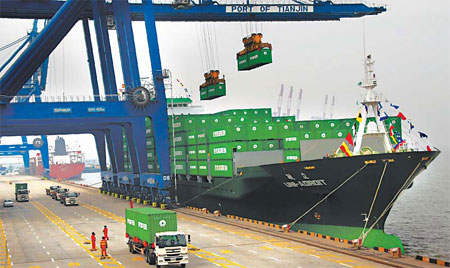|
|

A container vessel being unloaded at the Port of Tianjin. Xinhua
|
Major ports in the country are holding consolidation talks with regional rivals as resource duplication and stifling competition threaten to destroy profits at a time of dwindling business.
"Rationalization" now seems to be the buzzword among port operators.
For instance, the rationale of having two competing port facilities in Tianjin has always been questioned. Critics have also questioned the need for two large deep-water ports to serve the Yangtze River Delta region. At one point of time, nearly all townships in Guangdong harbored ambitions of building their own ports.
Recently, Hong Kong-listed Tianjin Port Development (TPD) made a HK$10.96-billion offer for a controlling stake in rival Shanghai-listed Tianjin Port.
TPD and Tianjin Port have been competing fiercely, especially on their overlapping container cargo handling businesses. The proposed merger, if it goes through, can strengthen Tianjin's position as a regional transportation hub, competing on an equal footing with ports in neighboring countries. Tianjin is China's third largest sea port by cargo throughput and the sixth largest by container throughput.
In the Yangtze delta region, the competition between Shanghai's Yangshan deep-water port and neighboring Ningbo-Zhoushan port was widely perceived as healthy when exports from the region were growing at a breakneck pace. In fact, these two ports were running neck-to-neck for the top spot among Chinese ports. And, in the first quarter of 2008 Ningbo-Zhoushan port ranked first in cargo throughput, surpassing Shanghai Yangshan port for the first time.
Now, the two rivals are reportedly talking to each other about a possible partnership, or even a merger.
In boom times, huge investments in overlapping cargo handling facilities in many coastal regions could easily be justified, or glossed over, due to the average 10 percent to 20 percent growth in cargo throughput seen each year. But times have now changed.
The first sign of trouble came in September 2008 when the throughput registered a monthly growth of below 10 percent for the first time in many years. The worst was yet to come. In the first two months of this year, the total throughput at all Chinese ports fell by 5 percent from a year ago, to 861.09 million tons.
Indeed, China's port industry has been severely challenged by a sharp decline in cargo and container throughput as the global economy sinks deeper into a recession.
As global trade continues to slump due to falling import demand, the slide in business at the nation's ports is expected to accelerate in the coming months.
"This year will be the hardest ever for Chinese ports, and the industry is far from bottoming out," Chang Dechuan, president of Qingdao port, China's fifth largest port by cargo throughput, told China Daily.
Commenting on the predictions made by some economists that the export sector would recover later this year, Chang said: "I am not that optimistic."
|

